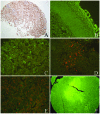Reduced expression of autophagy markers correlates with high-risk human papillomavirus infection in human cervical squamous cell carcinoma
- PMID: 25202355
- PMCID: PMC4156245
- DOI: 10.3892/ol.2014.2417
Reduced expression of autophagy markers correlates with high-risk human papillomavirus infection in human cervical squamous cell carcinoma
Abstract
Infection by an oncogenic human papillomavirus (HPV), in particular HPV16 and 18, is a high risk factor for developing cervical cancer; however, viral infection alone is not sufficient for cancer progression. Autophagy is hypothesized to be an important process during carcinogenesis. The aim of the present study was to investigate the association between autophagy and high-risk HPV (hrHPV) infection in human cervical squamous cell carcinomas (SCCs), and to analyze the clinical significance of this association. Quantum dot (QD)-based immunofluorescence histochemistry was used to detect the expression of autophagy markers, Beclin-1 and microtubule-associated proteins 1A/1B light chain 3B (LC3B) proteins, in 104 cases of cervical cancer (including 80 SCCs and 24 adenocarcinomas) and 20 normal cervical tissues. hrHPV (HPV16/18) infection was detected by QDs based fluorescence in situ hybridization in cervical cancers. The results revealed that the expression levels of Beclin-1 and LC3B were significantly lower in cervical cancer cells when compared with those of normal cervical squamous epithelial cells, and were found to negatively correlate with hrHPV infection. The expression levels of Beclin-1 and LC3B were not associated with age, tumor grade, tumor stage, tumor node metastasis stage or lymph node metastasis. However, a positive correlation was identified between Beclin-1 and LC3B protein expression. In addition, the absence of autophagy in combination with hrHPV infection may accelerate the progression of cervical SCC. In conclusion, decreased expression of Beclin-1 and LC3B may be important in cervical carcinogenesis. The hrHPV-host cell interaction may inhibit autophagy, which may aid virus duplication and infection, as well as cervical cancer development.
Keywords: autophagy; beclin-1; cervical cancer; human papilloma virus; light chain 3B; quantum dots.
Figures


Similar articles
-
Autophagy knocked down by high-risk HPV infection and uterine cervical carcinogenesis.Int J Clin Exp Med. 2015 Jul 15;8(7):10304-14. eCollection 2015. Int J Clin Exp Med. 2015. PMID: 26379821 Free PMC article. Review.
-
HPV-ISH-Negative Invasive Cervical Squamous Cell Carcinoma: Histologic and Pap Test Results.Acta Cytol. 2019;63(5):417-423. doi: 10.1159/000500595. Epub 2019 Jun 13. Acta Cytol. 2019. PMID: 31195388
-
Human papilloma virus early proteins E6 (HPV16/18-E6) and the cell cycle marker P16 (INK4a) are useful prognostic markers in uterine cervical carcinomas in Qassim Region--Saudi Arabia.Pathol Oncol Res. 2015 Jan;21(1):157-66. doi: 10.1007/s12253-014-9801-y. Epub 2014 Jun 13. Pathol Oncol Res. 2015. PMID: 24925218
-
Quantum dots-based immunofluorescent imaging of stromal fibroblasts Caveolin-1 and light chain 3B expression and identification of their clinical significance in human gastric cancer.Int J Mol Sci. 2012 Oct 24;13(11):13764-80. doi: 10.3390/ijms131113764. Int J Mol Sci. 2012. PMID: 23203033 Free PMC article.
-
HPV Integration in Head and Neck Squamous Cell Carcinomas: Cause and Consequence.Recent Results Cancer Res. 2017;206:57-72. doi: 10.1007/978-3-319-43580-0_4. Recent Results Cancer Res. 2017. PMID: 27699529 Review.
Cited by
-
Autophagy Gene Activity May Act As a Key Factor for Sensitivity of Tumor Cells to Oncolytic Vesicular Stomatitis Virus.Iran J Cancer Prev. 2016 Feb 22;9(1):e3919. doi: 10.17795/ijcp-3919. eCollection 2016 Feb. Iran J Cancer Prev. 2016. PMID: 27366311 Free PMC article.
-
Autophagy knocked down by high-risk HPV infection and uterine cervical carcinogenesis.Int J Clin Exp Med. 2015 Jul 15;8(7):10304-14. eCollection 2015. Int J Clin Exp Med. 2015. PMID: 26379821 Free PMC article. Review.
-
Autophagy in malignant transformation and cancer progression.EMBO J. 2015 Apr 1;34(7):856-80. doi: 10.15252/embj.201490784. Epub 2015 Feb 23. EMBO J. 2015. PMID: 25712477 Free PMC article. Review.
-
Human Papilloma Virus and Autophagy.Int J Mol Sci. 2018 Jun 15;19(6):1775. doi: 10.3390/ijms19061775. Int J Mol Sci. 2018. PMID: 29914057 Free PMC article. Review.
-
The role of pharmacologic modulation of autophagy on anal cancer development in an HPV mouse model of carcinogenesis.Virology. 2017 Jul;507:82-88. doi: 10.1016/j.virol.2017.04.007. Epub 2017 Apr 18. Virology. 2017. PMID: 28431282 Free PMC article.
References
-
- Pandey S, Mishra M, Chandrawati Human papillomavirus screening in north Indian women. Asian Pac J Cancer Prev. 2012;13:2643–2646. - PubMed
-
- Walboomers JM, Jacobs MV, Manos MM, et al. Human papillomavirus is a necessary cause of invasive cervical cancer worldwide. J Pathol. 1999;189:12–19. - PubMed
-
- Li J, Kang LN, Qiao YL. Review of the cervical cancer disease burden in mainland China. Asian Pac J Cancer Prev. 2011;12:1149–1153. - PubMed
-
- Muñoz N. Human papillomavirus and cancer: the epidemiological evidence. J Clin Virol. 2000;19:1–5. - PubMed
-
- zur Hausen H. Papillomaviruses and cancer: from basic studies to clinical application. Nat Rev Cancer. 2002;2:342–350. - PubMed
LinkOut - more resources
Full Text Sources
Other Literature Sources
Research Materials
